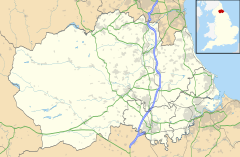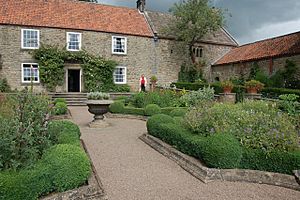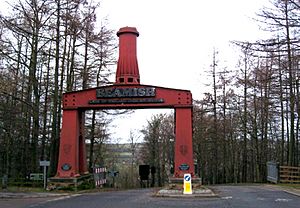Beamish, County Durham facts for kids
Quick facts for kids Beamish |
|
|---|---|
 Shepherd and Shepherdess, Beamish |
|
| OS grid reference | NZ225535 |
| Unitary authority | |
| Ceremonial county | |
| Region | |
| Country | England |
| Sovereign state | United Kingdom |
| Post town | STANLEY |
| Postcode district | DH9 |
| Dialling code | 01207 |
| Police | Durham |
| Fire | County Durham and Darlington |
| Ambulance | North East |
| EU Parliament | North East England |
| UK Parliament |
|
Beamish is a small village located in County Durham, England. It sits northeast of the town of Stanley. This charming village was once known as 'Pit Hill'.
Beamish is nestled within a beautiful area called Hell Hole Wood. It is most famous for being home to the Beamish Museum. This special museum is an open-air site that shows what life was like in a northern English town in the early 1900s. You can visit the Shepherd and Shepherdess pub, which is close to the museum's entrance.
Discovering Beamish Village
Beamish is surrounded by other interesting places. To the south, you'll find the village of No Place. This village is also known as Co-operative Villas.
The northwestern part of Beamish is a protected area. This area is called the Beamish Burn conservation area. It helps to keep the natural beauty of the landscape safe.
Pockerley Manor: A Historic Tower
North of Beamish, there's a historic building called Pockerley Manor. This manor includes a very old type of building called a pele tower. A pele tower is a small, fortified tower house. They were built in the 15th century to protect against raids.
The pele tower at Pockerley Manor is quite rare. It has been changed and added to over time. It is now connected to a farmhouse that was built later. The tower has living spaces above a stone basement. You can reach the first floor by a staircase built inside the thick wall. Much of the original roof is still there.
Beamish Museum: A Step Back in Time
The Beamish Museum is a major attraction in the area. It is a living museum where you can experience history firsthand. The museum shows what life was like in the North East of England during the 1820s, 1900s, and 1940s.
You can explore old shops, houses, and even a coal mine. There are also trams and buses that take you around the museum site. It's a great way to learn about the past in a fun and interactive way.




